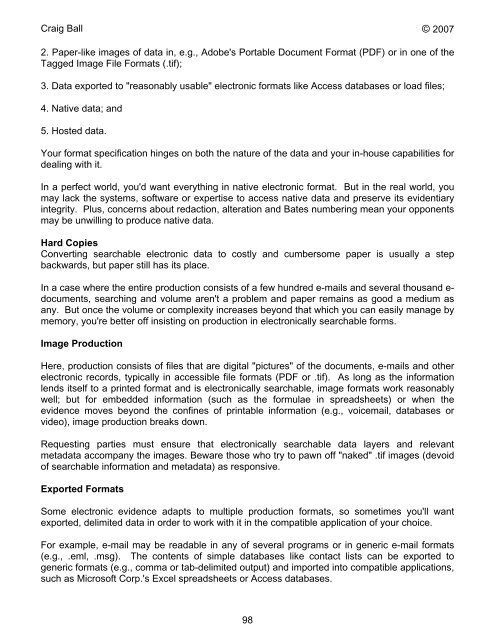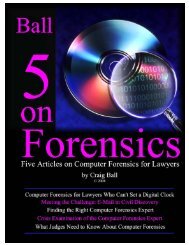Six Articles on Electronic - Craig Ball
Six Articles on Electronic - Craig Ball
Six Articles on Electronic - Craig Ball
Create successful ePaper yourself
Turn your PDF publications into a flip-book with our unique Google optimized e-Paper software.
<strong>Craig</strong> <strong>Ball</strong> © 2007<br />
2. Paper-like images of data in, e.g., Adobe's Portable Document Format (PDF) or in <strong>on</strong>e of the<br />
Tagged Image File Formats (.tif);<br />
3. Data exported to "reas<strong>on</strong>ably usable" electr<strong>on</strong>ic formats like Access databases or load files;<br />
4. Native data; and<br />
5. Hosted data.<br />
Your format specificati<strong>on</strong> hinges <strong>on</strong> both the nature of the data and your in-house capabilities for<br />
dealing with it.<br />
In a perfect world, you'd want everything in native electr<strong>on</strong>ic format. But in the real world, you<br />
may lack the systems, software or expertise to access native data and preserve its evidentiary<br />
integrity. Plus, c<strong>on</strong>cerns about redacti<strong>on</strong>, alterati<strong>on</strong> and Bates numbering mean your opp<strong>on</strong>ents<br />
may be unwilling to produce native data.<br />
Hard Copies<br />
C<strong>on</strong>verting searchable electr<strong>on</strong>ic data to costly and cumbersome paper is usually a step<br />
backwards, but paper still has its place.<br />
In a case where the entire producti<strong>on</strong> c<strong>on</strong>sists of a few hundred e-mails and several thousand e-<br />
documents, searching and volume aren't a problem and paper remains as good a medium as<br />
any. But <strong>on</strong>ce the volume or complexity increases bey<strong>on</strong>d that which you can easily manage by<br />
memory, you're better off insisting <strong>on</strong> producti<strong>on</strong> in electr<strong>on</strong>ically searchable forms.<br />
Image Producti<strong>on</strong><br />
Here, producti<strong>on</strong> c<strong>on</strong>sists of files that are digital "pictures" of the documents, e-mails and other<br />
electr<strong>on</strong>ic records, typically in accessible file formats (PDF or .tif). As l<strong>on</strong>g as the informati<strong>on</strong><br />
lends itself to a printed format and is electr<strong>on</strong>ically searchable, image formats work reas<strong>on</strong>ably<br />
well; but for embedded informati<strong>on</strong> (such as the formulae in spreadsheets) or when the<br />
evidence moves bey<strong>on</strong>d the c<strong>on</strong>fines of printable informati<strong>on</strong> (e.g., voicemail, databases or<br />
video), image producti<strong>on</strong> breaks down.<br />
Requesting parties must ensure that electr<strong>on</strong>ically searchable data layers and relevant<br />
metadata accompany the images. Beware those who try to pawn off "naked" .tif images (devoid<br />
of searchable informati<strong>on</strong> and metadata) as resp<strong>on</strong>sive.<br />
Exported Formats<br />
Some electr<strong>on</strong>ic evidence adapts to multiple producti<strong>on</strong> formats, so sometimes you'll want<br />
exported, delimited data in order to work with it in the compatible applicati<strong>on</strong> of your choice.<br />
For example, e-mail may be readable in any of several programs or in generic e-mail formats<br />
(e.g., .eml, .msg). The c<strong>on</strong>tents of simple databases like c<strong>on</strong>tact lists can be exported to<br />
generic formats (e.g., comma or tab-delimited output) and imported into compatible applicati<strong>on</strong>s,<br />
such as Microsoft Corp.'s Excel spreadsheets or Access databases.<br />
98













